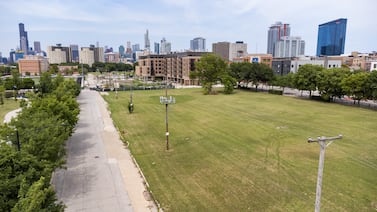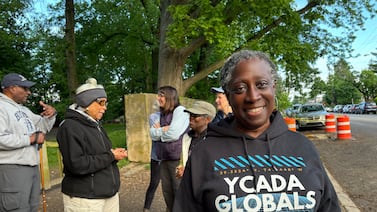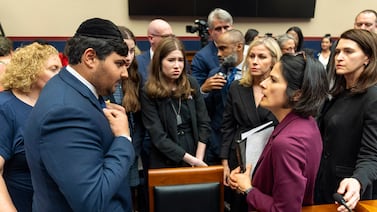Detroit’s school district needs nearly $10 million to return the Davis Aerospace Technical High School to the grounds of the Coleman A. Young International Airport.
Detroit Public Schools Community District Superintendent Nikolai Vitti told BridgeDetroit that the district is looking to privately raise $9.6 million with support from the DPSCD Foundation or to obtain a one-time earmark in this year’s state budget.
Relocating Davis Aerospace to the airport on the city’s east side will also require the district to convert one of the terminals into a school building. That would require removing escalators and luggage conveyor belts, installing a fire suppression system and alarm, adding newer mechanical equipment, and replacing the roofing system, he said.
DPSCD does not yet have any leads or funding commitments. But the project remains a priority for the district, which is aiming to have the move take place during the 2026-27 school year, Vitti said.
“The school board and I are fully committed to making the relocation happen,” Vitti said. “So if private funding or separate state funding is not provided, then we will prioritize this commitment in future district budgets.”
The continued push to relocate the aviation school comes amid forecasts that the industry faces a national shortage of pilots, maintenance technicians, and cabin crew members. Advocates say Davis Aerospace — one of few training centers for student pilots in Michigan — is a critical component of helping to fill the void.
In 2019, DPSCD decided that ninth-graders participating in the aviation program would be bused to the airport for afternoon classes. While the aviation school is still offering afternoon classes for its 100 students, the long-term goal of fully operating Davis Aerospace at the facility has stalled, with airport advocates and community members wondering what happened.
The delay was discussed at a January school board meeting by Keith Hines, a 1973 graduate and former electrical inspector for the city. He asked why the district hasn’t valued the importance of aviation education and the school, noting that Davis Aerospace has supplied numerous qualified mechanics for the aviation industry for years.
“Why can’t $50 million be set aside from the $700 million (facility master plan) for aviation education, technology skills and advancement since the demand is growing?” Hines said. “We need to see the stamped, finalized, approved plans for the Davis relocation project.”
The school was relocated from the airfield, better known as City Airport, to Golightly Career and Technical Center in 2013 while the district was under state-appointed emergency manager Roy Roberts. Without access to the airport, the school could no longer help students obtain the federal certification in aviation mechanics that would give them an inside track to steady, high-paying jobs.
“We did place $5 million in the (facility master plan) for the Davis move to the airport,” Vitti said. “However, we learned that the city could not use grant funds to support the facility work needed for the school, and costs of the facility increased due to flooding damage to the terminal. In addition, code costs were higher than expected from initial walkthroughs.”
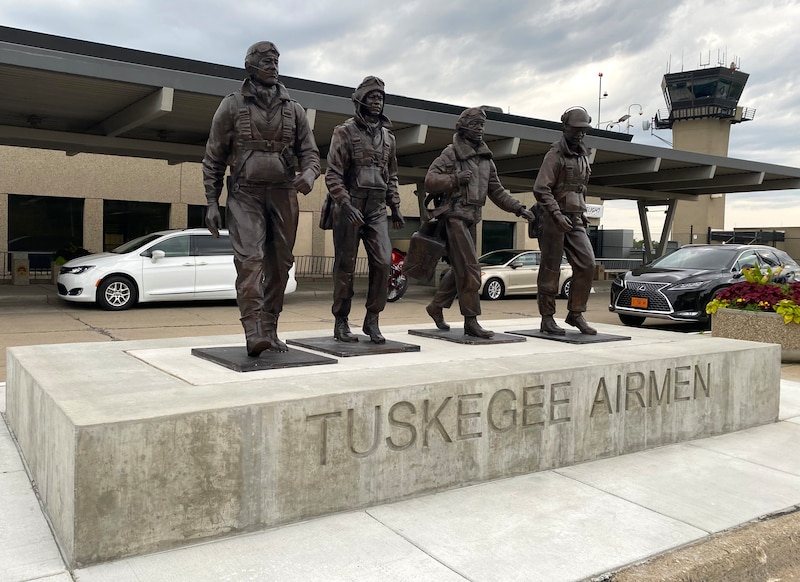
There are several aviation and aerospace high schools across the country, but Davis Aerospace is the only school of its kind in Detroit and one of few in Michigan. The most well-known school outside of Detroit is West Michigan Aviation Academy in Grand Rapids.
Beverly Kindle-Walker, executive director of Friends of Detroit City Airport, doesn’t understand why DPSCD needs $9.6 million to relocate and rehab Davis Aerospace. The nonprofit was founded in 1990 to expose young people to the fields of aerospace, aviation, and STEM.
“Just to inhabit it as a classroom structure, there’s no way it’s going to cost that much money, so we’re wondering where they’re basing it from,” Kindle-Walker said. “If they’re going to go into the private sector to raise money, I don’t know why they’re not making an effort to work on that. There are many people in the aviation field who are looking for pilots and mechanics, avionics, and all sorts of people who will be willing to partner with the public school system to help train their workforce.”
School fills ‘a critical need’ in developing aviation talent
Keith Newell, a former member of the Coleman A. Young International Airport Education Association, said that Davis Aerospace provides Detroit kids with career exploration and preparation for the aviation industry. And the need for new talent is critical, he said, especially with the aviation industry experiencing a shortage of pilots and mechanics.
In Boeing’s 2023 Pilot and Technician Outlook, the company projects that commercial carriers will need significant personnel through 2042 to support the global commercial fleet, including 649,000 pilots, 690,000 maintenance technicians, and 938,000 cabin crew members. This comes as domestic air travel has fully recovered from the pandemic, and international traffic is near pre-pandemic levels, the aircraft maker said.
In addition, pilots and mechanics are aging out of the industry, said Newell, who is now the manager at Wexford County Airport in Cadillac. Commercial airline pilots are required to retire at age 65, and air traffic controllers at 56 years old.
“Davis Aerospace fills a critical need in pipeline management,” he said. “They’re training kids on the skills that they’re going to need in those careers and then, depending if they become pilots or mechanics, some might require some college, some might not. But there are definitely paths to continue going to get into those careers.”
Detroiter Bin Userkaf graduated from Davis Aerospace in 2020 and had a positive experience at the school. While he mostly studied graphics and printing technology at Golightly, he still participated in aviation classes.
“After middle school, I realized I was not going to high school to make friends,” said Userkaf, now 21. “I really wanted to feel like I was ready to take on the world and a career in the field that I wanted to go into, and Davis had that. They just had great programs for people who actually wanted to do professional work.”
However, he remembered visiting an airport only once, and that was Detroit Metro Airport in Romulus. During his sophomore year, Userkaf said, there was an aviation class he took where students worked on the frames of cars. He said it would’ve been more fun if they had the opportunity to work on planes.
“I feel like it’s a disadvantage, because it’s a school that’s called Davis Aerospace and it’s down the street from City Airport,” Userkaf said. “By not having that as an avenue, it’s cutting off an entire part of what could be a really cool curriculum, even for people who might not be into aviation. It can just be a cool thing to learn, because you never know, it could ignite someone who was not initially interested into feeling like, ‘Wow, I feel like I want to pursue aviation.’
“People who find the school should be given a full experience of what Davis specifically has to offer instead of a generalized experience of flight,” he added.
Brian Smith, president of the Tuskegee Airmen National Historical Museum, also wants to see Davis Aerospace back at the airport. His organization, which hosts various programs and classes for children, teens, and young adults, is helping to fill a void for areas the school doesn’t have the capacity to teach, such as a flight academy and a full maintenance program, he said.
Roy Roberts “just took the teeth right out of what Davis was offering, which was a pathway to the middle class without college for our inner-city kids, the ones under-represented,” Smith said.
Sometimes, Smith gets asked whether he will open an aviation school. But his response is no, saying Davis Aerospace is still the best option for teens who want to pursue a career in the aviation industry.
“I want the school to be at the airport. I want it to succeed,” Smith said. “And I’ll go back to the role I had before the school at the airport was shut down, which was to take those students who could not attend Davis and give them the opportunity for flight.”
Leonard Shirley is one of the students enrolled in the Tuskegee Airmen’s flight academy. The 16-year-old is a 10th grader at Davis Aerospace and wants to become an airplane pilot. Shirley said he joined the Tuskegee Airmen program a few weeks ago to receive additional aviation instruction after school.
He said his class doesn’t come to City Airport often, and he believes he would have a better experience at school if Davis Aerospace was on site full-time.
“If someone is into being a pilot, they can actually take a test flight with an instructor,” Shirley said. “They’ve also got good mechanics and drone pilots, and we will actually be able to see the planes in front of us.”
Airport remains active, even after loss of a runway
David Tarrant has also advocated for the airport and aviation school.
Tarrant is the former executive director of the Coleman A. Young International Airport Education Association, a nonprofit made up of community advocates formed in 2017 when the airport was at risk of being shut down. But after the city announced its layout plan for City Airport in 2022, Tarrant stepped down as director, and the association has since become more of an informal organization, he said.
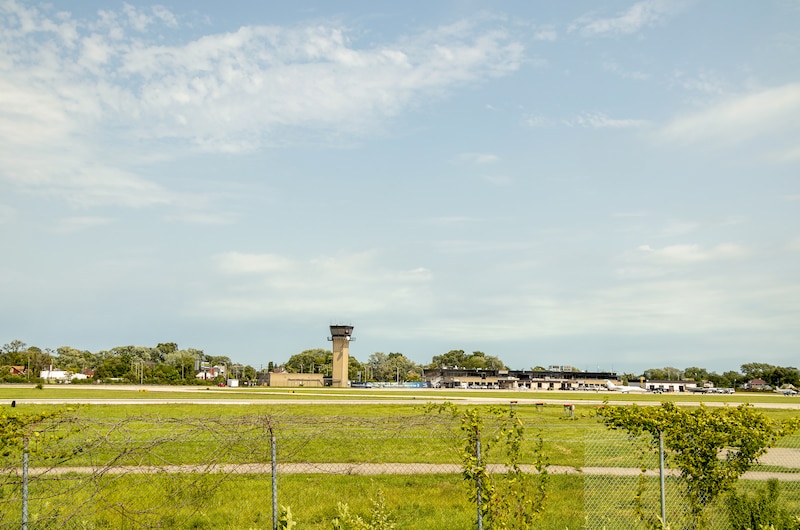
One of the issues the association was fighting for was to keep the use of a smaller, crosswind runway used during windy conditions and for inexperienced pilots. However, the Federal Aviation Administration approved the decommissioning of the runway in 2022, freeing up 80 acres of land for new development.
Tarrant said the crosswinds runway was important for training pilots, such as the students at Davis Aerospace.
“Student pilots have a lot of wind restrictions … and if you take the other runway away, it limits training,” he said. We won the strategic battle; we kept the airport, but we lost the tactical battle, which was to keep that runway.”
Today, the airport is used by private fliers, with hangar space leased to private and corporate planes. Kindle-Walker said even though commercial services ended more than 20 years ago, City Airport is still active with general aviation and medical transit.
The next generation of pilots and mechanics can help the airport overall and bring in revenue to the city, Tarrant said.
“There are so many bright, young minds that are being wasted if you don’t have a way to take the next steps,” he said. “There’s a crying need to give young people inside Detroit a way to give back.”
Kindle-Walker said Davis Aerospace students deserve to be in the atmosphere of an airport and receive hands-on training. It’s part of the school’s history since its inception in 1943.
“People don’t recognize the benefit of that school in the Detroit area,” she said. “We have people from all over: alumni who have gone into the military or the private sector who have an education that’s untouched coming from Detroit Public Schools. We want to get back to that but sometimes, they (the school board) seem to be reluctant to do just that.”
Micah Walker is a reporter for BridgeDetroit. You can reach her at mwalker@bridgedetroit.com.


